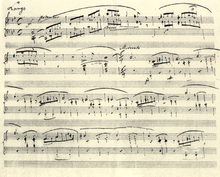Ballade No. 1 (Chopin)
The Ballade No. 1 in G minor, Op. 23 is a ballade for solo piano by Frédéric Chopin, completed in 1835. It is one of Chopin's most popular works.[1] A typical performance lasts nine to ten minutes.
History[]

The ballade dates to sketches Chopin made in 1831 during his eight-month stay in Vienna.[2] It was completed in 1835 after his move to Paris, where he dedicated it to Baron Nathaniel von Stockhausen, the Hanoverian ambassador to France.[3]
In 1836, Robert Schumann wrote: "I have a new Ballade by Chopin. It seems to me to be the work closest to his genius (though not the most brilliant). I even told him that it is my favourite of all of all his works. After a long, reflective pause he told me emphatically: 'I am glad, because I too like it the best, it is my dearest work.'"[1][4]
Structure[]

The piece begins in the first inversion of the A♭ major chord, a Neapolitan chord, which implies a majestic aura, ending in a dissonant left-hand chord D, G, and E♭ that is not resolved until later on in the piece. Though Chopin's original manuscript clearly marks an E♭ as the top note, the chord has caused some degree of controversy, and thus, some versions of the work – such as the Klindworth edition – include D, G, D as an ossia.[5]
The main section of the ballade is built from two main themes. The brief introduction fades into the first theme in G minor, introduced at measure 8. After dramatic development, the second theme in E♭ major is introduced softly at measure 68. The exposition is once again followed by development, in which the two themes, transferred to another tonal center (A minor and A major), undergo transformation. Then, a reprise presents the two themes in their original keys, albeit in reverse order.[4]
A thundering chord introduces the coda, marked Presto con fuoco, to which the initial Neapolitan harmony re-emerges in constant dynamic forward propulsion, which eventually ends the piece in a fiery double octave scale run down the keyboard.
As a whole, the piece is structurally complex and not strictly confined to any particular form, but incorporates ideas from mainly the sonata and variation forms. A distinguishing feature is its time signature. While the other three ballades are written in strict compound duple time with a 6
8 time signature, Ballade No. 1 bears deviations from this. The introduction is written in 4
4 time, and the more extensive Presto con fuoco coda is written in 2
2 or 4
4. The rest of the piece is written in 6
4, rather than the 6
8 which characterizes the others. It is also considered one of Chopin's most technically and musically demanding works.
Cultural references[]
The ballade is featured prominently in several films. It is performed on-screen in Gaslight by the Polish pianist Jakob Gimpel, credited as the Pianist. A performance of the piece is central to the plot of the 2002 Roman Polanski film The Pianist, where it moves a German officer to hide and supply with food the pianist, Władysław Szpilman, played by Adrien Brody. On the soundtrack, it is played by Janusz Olejniczak. It also appears in the 1991 film Impromptu, where Chopin is playing this piece when he is interrupted by George Sand and meets her for the first time.
The piece was also the subject of the 2013 Channel 4 documentary Chopin Saved My Life.[6][7] It is quoted in Mieczysław Weinberg's Symphony No. 21 ("Kaddish").[8]
A version of piece was also the final performance in the critically acclaimed Japanese anime Your Lie in April; however this arrangement also features a violin part on top of the original piano piece. [9]
In 2010, the editor of The Guardian, Alan Rusbridger, dedicated a year to learning Ballade No. 1 and produced a book about the experience, Play It Again: An Amateur Against the Impossible.[10]
References[]
- ^ Jump up to: a b Müllemann, Norbert (2007). Chopin Ballades – Preface. Munich: G. Henle Verlag. pp. IX–XIII.
- ^ Smaliek, William; Trochimczyk, Maja (2015). Fréderic Chopin: A Research and Information Guide (2nd ed.). New York and London: Routledge. pp. xxviii. ISBN 978-0-415-99884-0.
- ^ Orga, Ateş (1978). Chopin. p. 64. ISBN 9780846704164.
- ^ Jump up to: a b Tomaszewski, Mieczysław. "Ballade in G minor, Op. 23". Fryderyk Chopin Institute. Retrieved 18 December 2020.
- ^ Huneker, James (1921). Chopin: the Man and his Music. p. 414. ISBN 1-60303-588-5. Retrieved 5 January 2010.
- ^ Chopin Saved My Life at IMDb
- ^ "Chopin Saved My Life". Channel 4. Retrieved 16 May 2019.
- ^ Cookson, Michael. "Review: Recording of the Month". MusicWeb International. Retrieved 15 October 2014.
- ^ "A List of Music Pieces from "Your Lie in April"". Talk Amongst Yourselves. Retrieved 31 July 2020.
- ^ Winter, Robert (24 April 2014). "He Dove In and Did It". The New York Review of Books. Retrieved 15 October 2014.
External links[]
- Ballade No. 1 (Chopin): Scores at the International Music Score Library Project
- Compositions by Frédéric Chopin
- 1835 compositions
- Compositions in G minor
- Music with dedications
- Piano ballades
